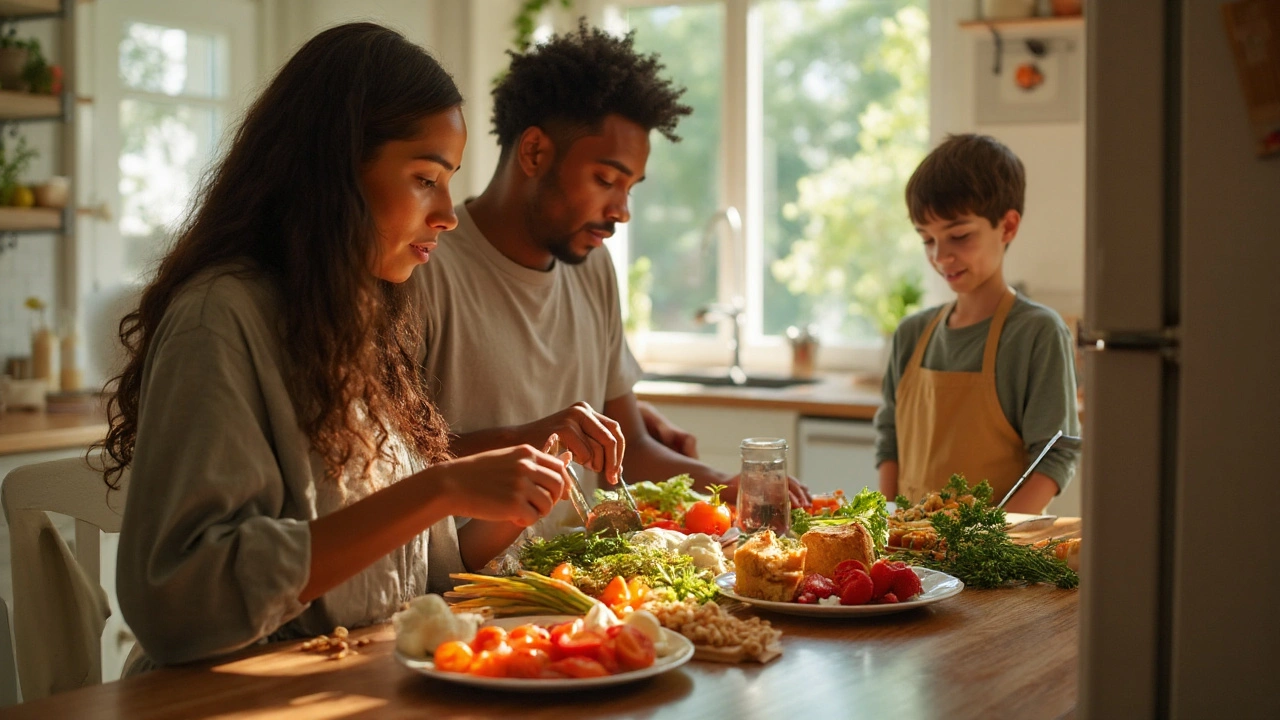
High LDL cholesterol is a quiet problem that builds for years, then shows up as a heart scare you didn’t plan for. Food won’t fix genetics, but the right pattern can cut LDL, tame triglycerides, and nudge blood pressure down. The Mediterranean diet has the best proof for real people in the real world-think extra-virgin olive oil, nuts, legumes, whole grains, fish, heaps of veg, and modest dairy. Expect steady, meaningful drops in LDL over 6-12 weeks, especially if you also swap out saturated fats, bump up soluble fibre, and add plant sterols. If you’ve got familial hypercholesterolemia or very high risk, you’ll still need medication; this plan makes the meds work better.
- Swap butter and fatty meats for extra-virgin olive oil, nuts, legumes, and fish. Aim for ~4 tbsp EVOO/day, 30 g nuts/day, fish 2-3 times/week.
- Hit 25-30 g fibre daily, including 5-10 g soluble fibre (oats, barley, psyllium, legumes). This alone can shave 5-10% off LDL.
- Use plant sterol-enriched spreads/yoghurts (2 g sterols/day) if LDL is stubborn; expect another 8-10% drop.
- Keep saturated fat low (ideally <7-10% of energy): trim red meat, choose low-fat dairy, watch cheese portions.
- Track numbers: LDL-C, non-HDL-C (or ApoB if offered), triglycerides. Recheck labs in 6-12 weeks and adjust.
The plan at a glance: what works and why
The Mediterranean pattern isn’t one food; it’s a stack of small wins that add up. Randomised trials back this. The PREDIMED trial (Spain, 2013; reanalysed 2018) showed fewer major cardiovascular events when people ate a Mediterranean pattern high in extra-virgin olive oil or nuts. The Lyon Diet Heart Study (France) found fewer recurrent heart issues on a Mediterranean-style plan after a heart attack. Mechanisms are simple: you replace saturated fat with unsaturated fat, add soluble fibre that traps bile acids (your body burns cholesterol to make more), and bring in polyphenols that protect LDL from oxidation. Net effect: lower LDL, better LDL particle quality, and calmer inflammation.
What’s realistic? Swapping butter and processed meats for EVOO and legumes typically drops LDL 5-15%. Add 5-10 g soluble fibre and you can take off another 5-10%. Plant sterols at 2 g/day add 8-10% on top. Lose 5-10% of body weight if needed and LDL can fall further (often 5-15%). Put together, diet changes alone can deliver a 10-25% LDL reduction for many people. If you’re on statins, this pattern helps your numbers and your long-term risk. If you have familial hypercholesterolemia, diet is necessary but not sufficient-you’ll need meds, sometimes two or three, guided by your doctor.
I’m in Sydney, so I’ll call out options you can grab at Coles, Woolies, or ALDI-tinned beans, Aussie EVOO, frozen salmon, wholegrain sourdough, barley, and plant sterol-enriched spreads are easy finds here.
Step-by-step: build your Mediterranean plate to lower LDL
Use this simple daily template. It’s not a rigid meal plan; it’s a rhythm you can stick to.
-
Make EVOO your default fat. Target ~4 tablespoons per day across cooking and dressings. Use extra-virgin for salads and low-to-medium heat; light/refined for higher heat if needed. Cook veg in it, drizzle it on soups, and whisk it with lemon for sauces.
-
Eat plants at every meal. Fill at least half your plate with vegetables (raw and cooked), plus fruit once or twice daily. Go colourful: tomatoes, leafy greens, capsicum, carrots, zucchini, eggplant, broccoli, mushrooms, berries, citrus.
-
Prioritise soluble fibre. Hit 25-30 g total fibre (5-10 g soluble) daily. Easiest wins: oats or barley at breakfast; a heaped tablespoon of psyllium husk in yoghurt or water; chickpeas/lentils with lunch and dinner. Four legume meals per week is a great baseline.
-
Choose whole grains. Swap white bread/rice/pasta for wholegrain sourdough, barley, freekeh, quinoa, brown rice, or high-fibre wraps. These keep you full and help your LDL.
-
Go fish 2-3 times per week. Use salmon, mackerel, sardines, or tuna (springwater or olive oil, not brine heavy in sodium). Fatty fish helps triglycerides more than LDL, but it replaces saturated fat-so your LDL benefits too.
-
Use nuts daily. A 30 g handful (almonds, walnuts, pistachios, hazelnuts) most days is linked to ~5% lower LDL. Sprinkle on salads, yoghurt, or eat as a snack.
-
Keep dairy modest and lean. Choose reduced-fat milk and yoghurt; keep cheese small (think 30-40 g). Skip cream and butter. If you love cheese, pick strong-flavoured varieties so you use less.
-
Trim red and processed meat. Red meat once or twice a week, small portions (80-100 g cooked), and choose lean cuts. Swap in legumes or fish most other nights. Avoid processed meats (bacon, salami) for LDL and overall heart risk.
-
Add plant sterols if needed. If your LDL is above target after 6-12 weeks, consider a sterol-enriched spread or yoghurt to reach 2 g/day. This is safe with statins and adds an extra 8-10% LDL reduction.
-
Drink smart. Water, tea, and black coffee are fine. If you drink alcohol, keep it light (no need to start). Wine with meals in small amounts is customary in Mediterranean regions, but health agencies don’t recommend drinking to prevent disease.
Quick label check: aim for foods with <3 g saturated fat per 100 g for everyday picks; <120 mg sodium per 100 g for breads and cereals; and >6 g fibre per 100 g for high-fibre grains. For spreads and oils, the higher the monounsaturated/polyunsaturated fat, the better.

Real-life meals (Australia): 7-day sample and easy shopping swaps
These are mix-and-match ideas you can pull together fast. I build around what’s on special at Sydney supermarkets and the local greengrocer.
-
Breakfast options (rotate):
- Overnight oats with barley flakes, grated apple, cinnamon, chopped walnuts, and a spoon of yoghurt. Add psyllium for extra soluble fibre.
- Wholegrain sourdough topped with smashed avocado, cherry tomatoes, EVOO drizzle, and a side of berries.
- High-fibre wrap with scrambled eggs, spinach, mushrooms, and a spoon of tomato salsa.
- Greek-style yoghurt (reduced-fat), chia, almonds, and kiwi. Stir in oats or a low-sugar muesli.
-
Lunch ideas:
- Chickpea salad: chickpeas, cucumber, tomato, red onion, parsley, lemon, EVOO. Add tinned tuna for protein.
- Leftover grain bowl: quinoa, roasted veg, mixed leaves, pepitas, EVOO-lemon dressing.
- Lentil soup with carrots, celery, onions, and a slice of wholegrain sourdough.
- Wholegrain pita stuffed with hummus, roasted capsicum, olives, and rocket.
-
Dinners:
- Tray-bake salmon with cherry tomatoes, zucchini, and olives; barley salad on the side.
- Olive oil bean stew: cannellini beans, spinach, garlic, chilli, lemon zest; serve with brown rice.
- Chicken thigh (skinless) baked with oregano, lemon, garlic; Greek salad with EVOO.
- Eggplant and mushroom ragù over wholemeal pasta, topped with parsley and toasted pine nuts.
- Stuffed capsicums with freekeh, lentils, herbs, and a dollop of yoghurt.
- Veggie paella: brown rice, saffron, peas, capsicum, artichokes, green beans; finish with EVOO.
- Grilled sardines or mackerel with roasted potatoes and a crunchy slaw.
-
Snacks:
- Almonds or walnuts (30 g).
- Carrot sticks with hummus.
- Fruit with a few pumpkin seeds.
- Wholegrain crackers with avocado or a sterol-enriched spread.
Shopping shortcuts I lean on: tinned beans and lentils (no-salt added if possible), frozen mixed veg, frozen salmon portions, tinned tomatoes, jars of roasted capsicum, olives, capers, and good Aussie EVOO. For plant sterols, look for sterol-enriched spreads or yoghurts; check the Nutrition Information Panel for sterol content per serve.
Cooking trick: roast a double tray of mixed veg on Sunday (capsicum, zucchini, mushrooms, onions, eggplant) with EVOO and herbs. Add to lunch bowls all week. Make a pot of barley or brown rice to anchor meals. Keep a jar of lemony EVOO dressing ready to go.
Cheat sheets, rules of thumb, and the evidence table
Rules I give friends and family:
- The 1-2-3 fat swap: 1 bottle of EVOO on the counter, 2 nuts you love, 3 fish meals per fortnight.
- Half-plate plants: at lunch and dinner, cover half the plate with veg. If you can’t, add a side salad dressed in EVOO.
- Fibre target: 25-30 g/day total, with 5-10 g soluble. If you’re short, add 1 tbsp psyllium to water once daily.
- Saturated fat test: butter in the house? If yes, you’ve got an easy win-replace it with EVOO or a sterol-enriched spread.
- Simple swap: meat-free Monday and Friday with legumes; fish on Wednesday. That rhythm alone moves your LDL.
How much can each lever move LDL? Here’s a practical snapshot based on large trials and guideline summaries (PREDIMED; Lyon Diet Heart; American Heart Association 2021 dietary guidance; Heart Foundation Australia nutrition advice; Cochrane reviews on fibre and sterols):
| Diet lever | Practical target | Typical LDL change | Notes |
|---|---|---|---|
| Swap saturated fat for unsaturated fat | Replace butter/fatty meats with EVOO, nuts, seeds, fish | ~8-10% drop per 5% energy exchanged | Backed by metabolic studies and heart guidelines |
| Soluble fibre | 5-10 g/day (within 25-30 g total fibre) | ~5-10% drop | Oats, barley, psyllium, legumes |
| Plant sterols/stanols | 2 g/day via enriched foods | ~8-10% drop | Safe with statins; check labels for sterol content |
| Weight loss (if overweight) | 5-10% body weight | ~5-15% drop | Varies; bigger impact if triglycerides high |
| Nuts daily | 30 g/day | ~5% drop | Almonds, walnuts, pistachios work well |
| Fish intake | 2-3 serves/week | Small LDL effect; bigger TG drop | Choose salmon, sardines, mackerel |
Put 2-3 of these levers together and you’ll see change by the next blood test. If you’re on a statin or ezetimibe, the combo is additive.
Quick checklist before you shop this week:
- Do I have a 750 ml bottle of EVOO ready?
- Have I planned 2 fish meals?
- Did I add beans or lentils to at least 4 meals?
- Is there a high-fibre cereal or oats/barley for breakfast?
- Do I have a sterol-enriched option if my LDL is above goal?
- Is cheese portion-controlled and butter out of the house?

FAQs, pitfalls, and next steps with your GP
Does this replace my medication? No. Diet and meds work together. For people with moderate to high risk, doctors often aim for LDL under 2.0 mmol/L; very high risk targets may be 1.8 or even 1.4 mmol/L per international guidelines. Your GP will set the right target for you.
What about eggs? For most people, up to 7 eggs per week is fine within this pattern. If your LDL runs high or you have diabetes, keep yolks modest and prioritise egg whites in omelettes.
Cheese and yoghurt-what’s safe? Choose reduced-fat yoghurt and keep cheese to small portions. Cheese is easy to overdo. Think of it as a flavour, not a main protein.
I tried keto and my LDL skyrocketed. Now what? That happens for some “hyper-responders.” Move to this Mediterranean pattern, swap saturated fats (butter, coconut oil, fatty red meat) for EVOO, nuts, and fish, add soluble fibre and sterols, and recheck labs in 6-12 weeks. If LDL stays high, talk to your GP about meds.
Is fish oil helpful? Fish oil is great for high triglycerides, not very strong for LDL. Eat fish; use supplements if your doctor recommends it for triglycerides.
Is wine “protective”? No one should start drinking for health. If you already drink, keep it light and with meals. Many Mediterranean regions drink wine, but the health benefits come mostly from the food pattern, not alcohol.
Budget tips? Buy tinned fish, dried or tinned legumes, seasonal veg, and whole grains in bulk. Frozen veg and berries are fine. EVOO can be the supermarket brand; choose extra-virgin.
Eating out? Look for grilled fish, bean-based dishes, salads with olive oil dressing, and veg sides. Ask for sauces on the side. Swap chips for salad or veg.
How fast will my numbers change? You’ll often see a measurable LDL drop in 6-12 weeks. Keep going; the benefits compound with time.
When to worry about inherited cholesterol (familial hypercholesterolemia)? If your untreated LDL is often above ~5 mmol/L, or there’s early heart disease in the family (men <55, women <65), ask your GP about FH. Diet helps, but you’ll need meds.
Which tests matter? LDL-C is the headline. Non-HDL-C (total cholesterol minus HDL) and ApoB are strong risk markers too. Triglycerides matter for metabolic health. Discuss targets with your GP.
Any Australian-specific guidance? The Heart Foundation Australia supports a Mediterranean-style pattern: more plants, legumes, whole grains, fish, nuts; less saturated fat and ultra-processed food. That lines up with the big international trials.
Common pitfalls and fixes:
- Pitfall: “Healthy” snacks high in saturated fat (coconut products, keto bars). Fix: nuts, fruit, yoghurt, hummus.
- Pitfall: Cheese creep-more slices than you realise. Fix: pre-portion 30-40 g, choose strong flavours, grate and sprinkle sparingly.
- Pitfall: Not enough soluble fibre. Fix: oats/barley at breakfast, legumes daily, psyllium top-up.
- Pitfall: Weekend blowouts undo weekday gains. Fix: plan one indulgent meal, not a whole weekend, and keep EVOO/veg centre stage.
Next steps by scenario:
- If you’re starting from scratch: adopt the fat swap (butter → EVOO) and add oats plus beans this week. Book a repeat lipid test for 8-12 weeks.
- If your LDL is close to target: tighten saturated fat, add 2 g/day plant sterols, and keep fish at 2-3 serves/week.
- If you’re on statins: keep the pattern; you may be able to hit lower targets or use lower doses-ask your GP.
- If you’re vegan or vegetarian: this pattern adapts well-use legumes, tofu/tempeh, nuts, seeds, whole grains, and sterol-enriched plant products. Watch saturated fat from coconut.
- If you have diabetes or high triglycerides: watch refined carbs; favour low-GI grains (barley, oats, legumes), and keep fruit to two pieces/day spread out.
- If you have kidney disease: talk to your doctor or a dietitian about protein, potassium, and phosphate limits before boosting legumes.
A note on credibility: The PREDIMED trial and the Lyon Diet Heart Study are the cornerstone randomised trials for Mediterranean-style eating and cardiovascular outcomes. The American Heart Association’s 2021 dietary guidance and Australian Heart Foundation advice back the core steps here. Cochrane reviews consistently show LDL-lowering for soluble fibre and plant sterols. You don’t need to memorise the references; you’ll feel it when your follow-up bloods come back cleaner.
Stick with the basics: olive oil instead of butter, plants in half your meals, legumes like it’s your job, fish twice a week, nuts daily, and cheese as a cameo. Do that, and your LDL will get the memo.
17 Comments
Randy Pierson
August 26, 2025 at 13:19 PM
What a kaleidoscopic cascade of culinary wisdom! Your guide paints olive oil as liquid gold and nuts as crunchy jewels, all while sprinkling a generous dusting of scientific sparkle. The vivid prose makes the whole Mediterranean tapestry feel like a vibrant, edible masterpiece that anyone can slice into their daily life.
Bruce T
August 29, 2025 at 10:46 AM
Listen up, folks: if you think you can dodge heart disease by munching on a few olives and calling it a day, you’re seriously selling yourself short. The only moral high ground here is putting in the effort, not expecting miracles from a drizzle of oil.
Darla Sudheer
September 1, 2025 at 08:13 AM
This looks solid. The steps are clear and easy to follow. I’ll start with the olive oil and nuts tomorrow. Thanks for breaking it down.
Elizabeth González
September 4, 2025 at 05:39 AM
The exposition presents a cogent synthesis of epidemiological data and practical guidance. By juxtaposing macronutrient substitution with quantifiable lipid outcomes, the author furnishes a robust framework for cardiovascular risk mitigation. The inclusion of region‑specific procurement advice further enhances applicability. Overall, the discourse exemplifies a methodical approach to dietary modulation of dyslipidemia.
chioma uche
September 7, 2025 at 03:06 AM
This so‑called Mediterranean craze is nothing but a Western export trying to hijack our native cuisines. Stop pretending it’s the only path to health and respect the richness of our own dietary heritage.
Satyabhan Singh
September 10, 2025 at 00:33 AM
While I acknowledge the persuasive rhetoric employed herein, it is imperative to recognize that the Mediterranean paradigm, though efficacious, is but one among a constellation of culturally resonant dietary schemas. The annals of nutritional science affirm that adaptability to regional palates, coupled with evidence‑based macronutrient adjustments, yields comparable cardioprotective benefits. Hence, the discourse should embrace a pluralistic perspective rather than promulgate a singular hegemony.
Sebastian Samuel
September 12, 2025 at 21:59 PM
😂 Wow, look at all this high‑falutin talk! Honestly, if you’re scared of a little butter you’re missing the point. Eat what you love, just don’t overdo it 🙈🔥
Mitchell Awisus
September 15, 2025 at 19:26 PM
Great thread, everyone, and I’d just add, while we’re swapping fats, remember to watch the sodium, the hidden culprit, and also keep an eye on portion sizes, because even the best foods can become foes if we overindulge, and don’t forget to stay hydrated for overall metabolic health.
Annette Smith
September 18, 2025 at 16:53 PM
Health is a journey, not a destination. Small, consistent changes lead to lasting benefits.
beth shell
September 21, 2025 at 14:19 PM
Indeed, each bite is a step toward better health.
khushali kothari
September 24, 2025 at 11:46 AM
The lipid profile modulation described herein is underpinned by robust mechanistic pathways: monounsaturated fatty acids attenuate hepatic cholesterol synthesis via SREBP-1c downregulation, while soluble fiber enhances bile acid sequestration, prompting hepatic upregulation of LDL receptor expression. Consequently, the net effect is a statistically significant reduction in circulating LDL-C concentrations.
Brandon Smith
September 27, 2025 at 09:13 AM
Clearly, the author overlooks the moral imperative of personal responsibility; education alone won’t fix the epidemic without disciplined adherence.
darwin ambil
September 30, 2025 at 06:39 AM
Yo, this guide is solid! 🙌 Just remember to keep it real and don’t stress about perfection. 😎
Kelvin Van der Maelen
October 3, 2025 at 04:06 AM
The tragedy of neglecting olive oil is palpable.
Joy Arnaiz
October 6, 2025 at 01:33 AM
One must wonder whether the promotion of this diet is part of a larger agenda to steer public consumption toward multinational agribusiness interests, cloaked in the veneer of “health”.
Christopher Eyer
October 8, 2025 at 22:59 PM
While the guide is well intentioned, i cant help but notice some inconcistancies. For exampel, the claim about 8-10% drop from sterols seems overblown, especially when you factor in real world compliance. Also, the tone gets awfully preachy at times – coudl use a bit more balanced approach.






Marvin Powers
August 23, 2025 at 15:53 PM
Congratulations, you’ve just uncovered the ancient secret of not dying from heart disease, and it only took a 2025 guide to tell you.
Swap butter for olive oil? Groundbreaking.
Add a handful of nuts daily and you’ll feel like a superhero with cholesterol levels that finally obey the law.
Load up on soluble fibre and watch your LDL melt away like butter in a hot pan, except it’s actually good for you.
Four tablespoons of extra‑virgin olive oil a day might sound like a culinary extravagance, but your arteries will thank you with every quiet beat.
Remember, the Mediterranean diet isn’t a rigid menu, it’s a flexible lifestyle that whispers sweet nothings to your lipid profile.
Eat half your plate full of veggies and you’ll be providing the body with the antioxidants it craves.
Fish two to three times a week brings omega‑3s that soothe inflammation while making your dinner look Instagram‑worthy.
Plant sterols are the unsung heroes silently blocking cholesterol absorption, so sprinkle that enriched spread on toast like confetti.
Weight loss, even a modest 5‑10%, can shave another chunk off your LDL, proving that the scale really does matter.
Don’t forget the power of whole grains; barley and oats are the friendly fibers that trap bile acids and force the liver to burn cholesterol.
The studies, from PREDIMED to Lyon, are not just academic fluff; they are the hard‑won evidence that this pattern reduces heart attacks.
If you’re on statins, this diet is the sidekick that lets you aim for lower targets without increasing dosage.
Think of it as a long‑term partnership rather than a quick‑fix diet, because consistency is the real superhero here.
So roll up your sleeves, drizzle that olive oil, and let the Mediterranean magic do its thing.
And remember, if your LDL doesn’t budge, it’s time to call the doctor, not to blame the diet.